
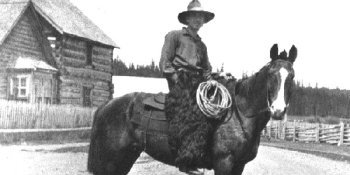

|

|
| Home | Conservation | History |
Bridge Creek Ranch History1868 to PresentTHE RUSH FOR GOLD: 1860sThe origins of Bridge Creek Ranch and the town of 100 Mile House begin in the early 1800s when the region's bountiful wildlife attracted fur traders. The Hudson's Bay Company's historic fur Brigade Trail ran from Kamloops to Fort Alexandria, and the valley of Bridge Creek became a favourite campground, offering green pastureland and fresh water. When a small settlement was built here it became known as 'Bridge Creek,' named for the bridge built circa 1827. When gold was first discovered in the early 1860s, a stream of adventurers began to ply the long road north from Vancouver to the Cariboo. The primary modes of travel were by steamship as far north as Lillooet, and then by stagecoach and wagon north to Barkerville. Between 1862 and 1870 over 100,000 people travelled the Cariboo Wagon Road, many from as far away as the British Isles, China, Australia, Germany and Russia. Travel was by stage-coach during the summer and horse-drawn sleigh in the winter. Passengers were wrapped in buffalo hides and warmed by heated stones to survive the sub-zero temperatures during winter journeys. Stopping houses were built along the way to service the horses and road-weary travellers. In the summer of 1861 'Bridge Creek House' was built and would later be called '100 Mile House' for its distance from Lillooet, 'mile zero' on the Gold Rush Trail. The single-storey structure contained a bar-room and kitchen on the main floor and a sleeping area in the attic. Due to the demands of increasing road traffic, by 1867 Bridge Creek House had become a line of five adjoining buildings, the original containing a store and telegraph key. Bridge Creek House and the adjoining ranchland, some 3,000 acres where more than 700 head of cattle ranged, underwent a series of owners until the end of the 1800s when it was purchased by the Stevenson brothers, Frank and Sydney. The brothers established a sawmill at the nearby waterfall on Bridge Creek. It was the Stevensons who built a large barn across the road from Bridge Creek House to stable the stagecoach and wagon horse teams, and to this day it still stands east of the highway at the north end of the village. |

A BX Express stagecoach stopping on the gold rush trail. 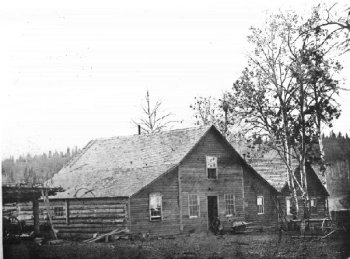
Bridge Creek stopping house in 1868. |
|
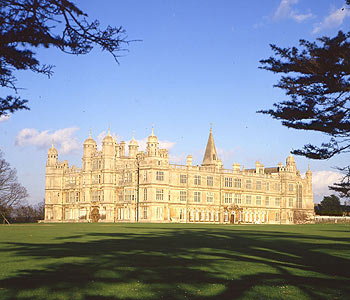
Burghley House in England, ancestral seat of the Cecil family. THE MARQUESS OF EXETER BUYS BRIDGE CREEK RANCH: 1912In 1912 William Cecil, the 5th Marquess of Exeter, purchased Bridge Creek House and 12,000 acres (4,800 hectares) of ranchland surrounding it. At this time in history it was fashionable for British noblemen to purchase land in 'the colonies.' He hired a Williams Lake real estate agent, C.G. Cowan, to manage the ranch, and made periodic visits with his wife to ensure everything was running smoothly. By 1917 the PGE railway through the Cariboo was completed, spelling the end of the stagecoach era. 100 Mile House continued to be a popular stopping point however for rail travellers disembarking at the newly-named 'Exeter' Station, and for fur traders and pioneers continuing to ply the Cariboo road northwards. |
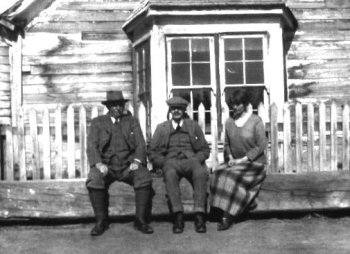 The Marquess and Marchioness of Exeter (center and right) with ranch overseer C.G. Cowan 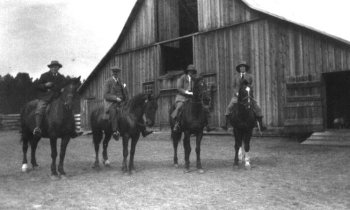
Left to right: C.G. Cowan, the Marquess of Exeter, Vivian Cowan and the Marchioness of Exeter. |
|
A YOUNG ENGLISH LORD BECOMES A RANCHER: 1930sThe Marquess of Exeter's younger son, Lord Martin, was a young lieutenant in the British Navy when the chance came for him to leave his promising career to manage his father's ranch in Canada. He welcomed the opportunity, and in 1930 arrived at the tender age of 21. A more contrasting life to his privileged upbringing in a stately British home cannot be imagined. Lord Martin rolled up his sleeves and worked alongside his ranch hands, branding cattle, riding the range, constructing outbuildings, and overseeing the small general store. Martin couldn't have taken on the responsibilities of the ranch at a worse time. This was the era of the Great Depression, and cattle prices, already low, plummeted. A local rancher was later to comment, "Lord Martin had patches on his jeans, just like the rest of us." There was no money from the ranch for him to draw a salary, but he continued to pay his staff and avoid the indebtedness which was rife at the time. |
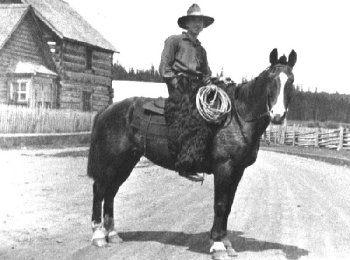
Lord Martin on horseback, 1930s |
|
|
At that time the ranch had a herd of 2,000 Merino sheep, and in late winter it was a common sight for Martin to have newborn lambs warming indoors by his hearth. The sheep would soon be phased out and cattle retained as the primary stock on the Bridge Creek Ranch. BUILDING THE LODGE: 1932One of Martin's early projects was to build the Lodge. By the early 1930s the original stopping house was run down and badly in need of replacing. Although he had little knowledge of construction, Martin drew on his excellent engineering skills from the Navy, and designed a fashionable new two-story lodge. He would study books on carpentry and plumbing by lamplight at night, and build by day. In 1932 the Lodge opened its doors for business, offering travelers the conveniences of modern plumbing, 'hot and cold running water in several bedrooms,' electric light (powered by a generator), and meals from local ranch produce such as roast beef, farm fresh eggs and butter, vegetables and freshly baked bread. 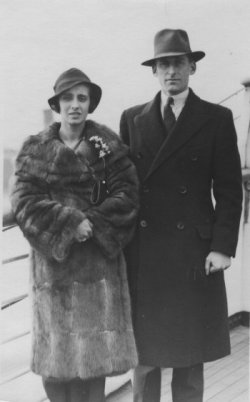
Another benefit of completing the Lodge was that Martin now had a suitable home to bring his wife to. He had met Edith Csanady, a young Hungarian debutante, in 1929 while in the Mediterranean with the Navy. They fell in love and kept a correspondence for five years until they could marry in 1934. One can only imagine the courage Edith would have gathered to leave her privileged life in Europe for the wilderness of Canada. |
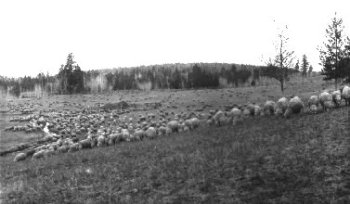
Some of the 2,000 herd of Merino sheep. 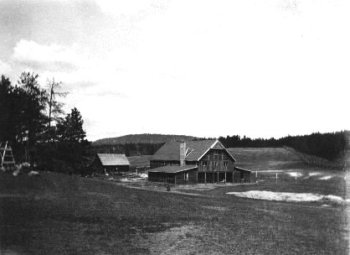
The Lodge, completed in 1932, with carpentry shop in background. 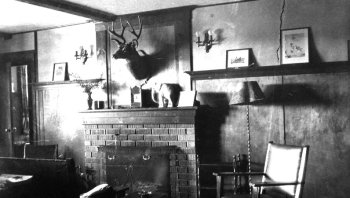
Hearthside at the Lodge, 1930s. |
|
|
For wilderness it still was, requiring a hardy breed of people to settle it. Edith assisted with the management of the Lodge, from hiring staff to cook and clean, to hosting the disparate range of travelling guests -- from English gentry to rough and tumble hunters who kept everyone awake through the night with their carousing. The conveniences of reliable electricity and paved roads would not arrive until after the second world war, and much of the travel at that time was still by horseback. Running water was a luxury only in the summertime; in winter it was drawn from Bridge Creek and transported by horse-drawn sleigh to the Lodge. The original 100 Mile House burned down in 1937, by then a run-down, vermin-infested building. Lord Martin was heard to remark at the time of the "terrible loss of life - none of which was human." In 1935 a son was born to Martin and Edith, and in years to come Michael would work alongside Martin to learn more of the ranch responsibilities. After completing his education in England, Michael returned to manage the general store in 1954 (the old one burned down in 1946) and for many years worked directly on the ranch. Martin was now overseeing 50,000 acres which included his own ranch as well as the management of an adjacent estate. Cattle ranching provided the main, if meagre, income for the locals. By the 1950s the local economy shifted from a reliance on ranching to logging and sawmills. Martin was elected president of the Cariboo Cattlemen's Association, which strove to present a united voice within the provincial and national market. |
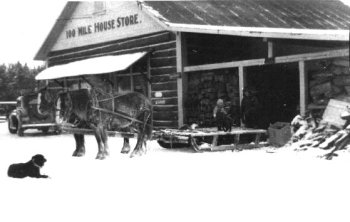
Horsedrawn sleigh for transporting water to the Lodge (front of 100 Mile House store, 1930s). 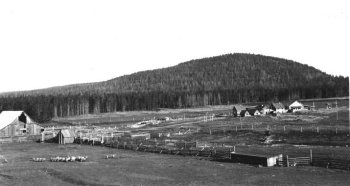
Bridge Creek Ranch outbuildings, 1930s. |
|
A TOWN IS BORN: 1960sUnlike other Cariboo towns which grew in a haphazard way, the orderly expansion of 100 Mile House benefitted from the foresight and overview Martin provided. He was ably assisted by Ross Marks, who worked for Bridge Creek Estate from 1949 until his passing in 2009. With the construction of Highway 97 through 100 Mile House, the number of commercial and residential buildings began to grow, and Martin gave up prime agricultural land to facilitate the development of the town. Some of the land was donated to help foster its growth: parkland both along Bridge Creek (now named Centennial Park) and at the marsh bird sanctuary, land for a school, an airport, a recreation arena, ball diamond, rodeo grounds, and the hospital. By 1960 there were enough villagers in the town to form its own government, but a majority voted for the ongoing management by Bridge Creek Estate. In 1965 the government vote was approved, and Ross Marks was elected mayor in recognition of his already excellent management of the town. |
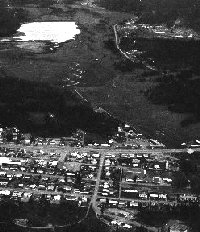
100 Mile House in 1966. |
|
100 MILE HOUSE TODAY...... is a thriving community of several thousand people, serving an economic circumference of approximately 20,000 people. Famous as a cross-country skiing 'mecca' with its annual marathon, the area boasts over 200 km of groomed ski trails and the world's largest pair of cross-country skis (11 metres) which stand outside our Tourist Information Centre. Horseback riding, canoeing our many lakes, fishing, mountain bike riding, snowmobiling and dogsledding are just some of our year-round activities, and wildlife such as moose, deer, bear, bald eagles, sandhill cranes, great blue herons, and countless species of songbirds and waterfowl grace our forests and lakes. In 1954, Martin married Lillian Johnson, following the death of his first wife Edith. A daughter, Marina, was born to them in 1956. In 1988, after a long and fulfilling life, Martin passed away. A few years later the ranch and other properties were divided evenly between Michael and Marina, with Lillian retaining participation in both enterprises. Marina continues horse and cattle ranching at 100 Mile Ranch east of the village. |
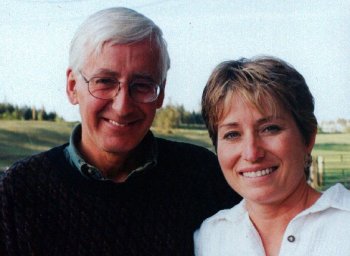
Michael with sister Marina. |
|
|
Wanting to take the ranch in a new creative direction, Michael Cecil hired Don Savjord as Bridge Creek ranch manager in 1995. Bringing extensive experience in ranching, conservation and animal husbandry, Don was instrumental in working with government and conservation groups to impliment a vision of stewardship for the land. Don's great strengths include seeking win/win solutions and an attitude of continuous improvement, always striving to ask, “How can we do this better?” After 25 years of care for the land, Michael's company was approached in 2020 by the Province of BC, through the Ministry of Indigenous Relations and Reconciliation, regarding purchasing the Ranch as part of the Provincial treaty process with the Canim Lake Band (Tsq'escen'). We are pleased that the transfer of the Ranch was completed in December 2022, and that the people of Tsq'escen' will now be the stewards of this property. We wish them the very best so that they are able to carry forward our deep care for the land and water in this place. |

Don Savjord, Ranch Manager |